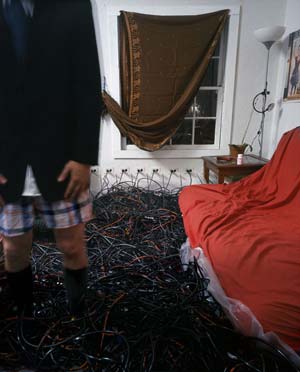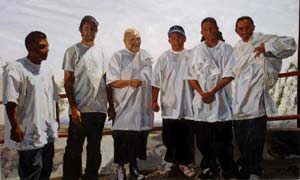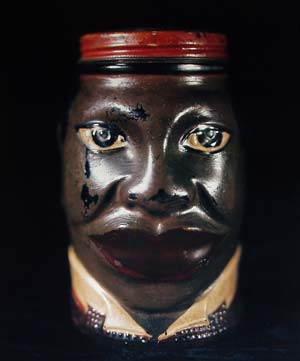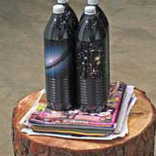Welcome to Tasty Tread, a sample "meal" of what is going on in Houston this month:
Appetizer:
Group Dynamic at the Foundry
The University of Houston's art department is starting to not suck; examine this show for some evidence, please:
In the Foundry's main hallway — you have to bang on the door if you want to see it – are pieces that think they are about fitting together, but not for a few years. Jonathan Bruder's photo work shows him rearranging an elevator into a living room: receiving guests, having cocktails. (The actual event could have been more emphasized instead of the documentation, but it's good.) Another gem is Johnny Diblasi, who anonymously photographs himself in a room full of electrical cords. The best part is that he installs dozens of nonfunctional power outlets and runs thousands of feet of cord going nowhere just to take the picture!
Carissa De La Cerda, also worth mentioning, rearranges images from laminated Catholic devotionals using Photoshop, replacing comfortable faith with physical help. She gives the just-crucified Jesus laying in the arms of his grieving mother a wheelchair. Her technique for keeping the digital glitches out when splicing images is very smart; in addition the 200 re-engineered devotionals she dispensed during the opening won viewers over. I'm pissed I was too late to get one. I must congratulate Kara Duval for showing in South Korea's Yeongwol Photo Festival next time I see her. In the show at UH, Duval and Paige Majko both show torturous images, or rather, images of torture. As a large body of work they may be impressive, but at three to a panel they cannot encompass the depravity and hopelessness they aspire to communicate. But regardless, whether as shady and half-seen dead bodies in Kara's hands, or overt and iconic beating and binding in Paige's, these are relevant and haunting images.
Ensalada:
Aimee Jones and Vicki Fowler at Brasil Café
Showing in a coffee shop is tough; long a mainstay for landscapes and bad abstractions with gold leafing, the stigma of staleness is hard to shake (realistically, people are there for other reasons). Luckily, Brasil is the locus of three or four projects – the boutique Raye, Microcinema International, the now-defunct galleries Mixture and Maas, and the new bookstore Domy – by Dan and Magda Fergus on the corner of Dunlavy and Westheimer. Dan Fegus has recently taken more of a chance on a range of art being presented at Brasil, including the Death to the Non-profits paintings by Mark Flood and a terror-inspired performance by Frank Olson and Nick Merriwether.
Perfectly informal, Aimee Jones and Vicki Fowler's work is large and silly enough to confuse most passersby; at least as much as the two girls running around at the opening did. Jones's crazy sloppy tire swing, puking pink crepe ribbons into the room is one of the most unsubtle sculptures. I hope someone gets really mad at it. Less jarring but also perfectly out of place is one of Fowler's sculptures: a white cone protruding from a brick wall, with a fabric carrot suspended just past the open end of the cone. The problem is that the view always contains a table and chairs right below it (and more often than not some dude studying for midterms). The work here unfortunately falls prey to the environment, not as a particular failing of any piece but as a curatorial message. The more art attempts to interact with the everyday and leave the white box behind, the more these concerns are pressing. Social artworks have been the strength of Jones and Fowler throughout this past year, in performances and events, but here they let down their seriousness for a chance to throw a show up on the fly. It didn't work out as well as one may have hoped.
Main Course:
2006 Core at Glassell (5100 Montrose)
Sasha Dela and her installations of the everyday have grown in her first year as a Core Fellow; after traveling to Cali, Minnesota, and Florence with balled-fist work, she's opened up formally and conceptually here in Houston. Dela lets her compositions spread out and encourages viewers to interact with another. Working with logs, cotton towels, plastic bottles and glossy mags, Dela seems to mash together vacant consumer culture trash that references the tamed outdoors with critiques of how stupid Americans are, consuming with little regard for what's actually on the end of their fork. The one smaller work, a log stacked with piles of Star and People topped off with a layer of liter water bottles, is really forgettable in the face of a nearby conversational installation remarkable for its destruction of narrative (the hints it drops are so lucid it's totally a stuttering savant). The other cool piece nearly disappears into the everyday of the Glassell; did you notice there are water bottles under the bench? They're filled with black ink. Did you read any of the books on the wall? Now there's a good surprise I won't spoil.
The constructions of Jonathan Durham greet you first as you come in the back entrance to the exhibition. The materials make it look like a kid made it, winding nonsensical clusters of tubes and metal pins. If a kid made this he wouldn't have painted it such a boring way, nor would it have been mounted so reverently. It really takes several years at a major institution to make you that diluted. Seeing images of Durham's older interventions, his compositions and materials are pretentious but still make sense. These really shouldn't be standing alone; the content seems to hope to be entirely internalized.
Citing an expressionist pedigree for the emphasis of his work, Philip Maysles extensively quotes Robert Motherwell and his explanations for painting in black and white. While Motherwell waxes romantic in his manifesto on the power to monochromatic painting, the artist here sees something deeper. By taking sociological associations from a formalist's treatise on 'purity,' Maysles arrives at a concept he fully believes in. The work on the wall happens to be Maysles painting black people and white people, a bad portrait of Frederick Douglass next to a bad portrait of John Brown with a Motherwell quote beneath it. A painting of a group of B-boys striking poses. Maybe they're Black, maybe they're Hispanic. Maybe they're gangsters, maybe they're not. They're not painted very well, that's for sure. Next to them is a speaker mounted into the wall, a 6XL white shirt hangs from a metal hanger on the speaker. Is this an ape of “In da Hood,” a readymade, or what? It seems inefficient, the references dangling like so many participles. Maysles comes off as having a shtick instead of a style.
Carl Suddath always makes me mad. I sure want to hate his small sculptures, pathetic little wooden things speaking under their breath if at all. But givena little time, the weightlessness of these objects can be majestic. Suddath presents a steel geometric sculpture painted mellow yellow so low to the ground it's ankle biter height. Goddammit Carl! Walking around it, the steel seemed to matter less and less as a radiant weightlessness reduces the sculpture to a piece of folded paper; truly remarkable. Suddath's small drawings on the wall read rather schizophrenic, an insight into the artist's process through mindless repetition and pleasing forms of the hand.
Man-about-town Demetrius Oliver gets a little out of his comfort zone here, off the wall where his C-prints usually hang, and away from the solid eternal images of his conceptual symbolist work. Bringing references to Dutch painting and Kafka to mind this installation consists of a nearly animated slide show of images of a suited Mr. Oliver wandering his bedroom as a reflection in a tin kettle, which is projected onto a mirror to double the image size on the same wall the projection is coming from (an old projectionist's trick). All in all it is creepy, disheartening, tough, thick and chewy, like a bagel, emotionally heartfelt and painful to examine.
Michael “I wasn't in Spinal Tap” McKean really needs a bigger playground. After his showing in the collaborative Leg at Lawndale nearly ate the other participants, McKean pulls out the big guns here in the center gallery of the Glassell. Two big blue rectangular shapes of different weights but the same fucking size glared out of the composition at me. Several hundred pounds of clay at the head of the installation cascade down the face of a wooden construction sitting on a stage. There is an angular composition of colored transparent panes backed by fluorescent light to the left of the main stage. Damn. McKean tries to combine detritus, commercial products and raw materials to compose something indescribable as narrative. In that he sure succeeds, but this one is a little satisfied, unresponsive to the particular white box it's in. Cool, definitely cool, but something doesn't fit.
Gilad Efrat and Leslie Hewitt are the last two; their sample showings maybe need some background to be appreciated properly. Hewitt's stack to the ceiling of home-labeled VHS tapes was previously exhibited at Project Row Houses, where the show's environment really added some punch to what becomes a whisper in the white box. The PRH show included Hewitt as a collaborator with William Cordova, their combined handicraft culminating in a series of obscure films shown in their row house that really fleshed out her VHS stack as a backdrop rather than a stand-alone work.
Efrat's work, representational and well-made to that end, is a series of large portraits of chimpanzees done in faded layers of subtly contrasting paint. His technique, involving the removal rather than application of oils, is intriguing, and his subject matter clearly attempts to make a social statement. Unfortunately, in the presence of such polarizing installations, one would have to be wholeheartedly motivated to single out the work for meaning or praise.
Dessert:
Lecture/ Panel Discussion at the Menil: David Levinthal, David McGee, Dr. Charles Rowell and William Christenberry
Monday, March 20 7:30 p.m.
The Menil Collection
Insistent Objects: David Levinthal's 'Blackface'
Photographer David Levinthal has been photographing miniatures with large format cameras for years, and since 1998 has been documenting Sambo-style caricatures in toys and household items including some of the Menil's vast collection. Levinthal started off his lecture by showing his older work, mostly recreations of Nazi history. No objections to his work can be brought without all kinds of sensitive PC issues being brought up, and as the artist insists, he never had the influence nor the inclination to be racist in his life or his photography. Still, that's a little fucked up. Two major projects in his career, Nazis and Blackface. Ok, man.
David McGee has garnered a reputation as an artist slaughtering cows (some of them sacred), snapping up European modes of painting and fusing them with black imagery. As the curator of Deep Wells and Reflecting Pools, McGee spent days poring through the Menil's collection of ephemera, digging deeper than few others have.
Dr. Charles Rowell and William Christenberry grew up in the same area of Alabama during the fifties and sixties. Dr. Rowell works at Texas A&M and, as he says, “accepts every invitation he receives to leave the great intellects of College Station.” While traveling between universities for some thirty years, Rowell has edited the righteous literary journal Callaloo, an ever-expanding voice for writers within the black community, including southerners, ethnically African Mexicans, and Caribbean writers.
William Christenberry was paired here with Levinthal for a similarity in their work. Formally they have both used miniatures often; conceptually they use racially loaded imagery without a racist aim. Christenberry has long been fascinated with the image of hooded Klan members, and has dressed many, many GI Joe dolls in tiny Klan outfits.
Running for near to an hour and a half, the discussion faltered in its aim to discuss the implications of showing Levinthal's work in this community, and how responsibility for the artist is handled. Dr. Rowell explained how white America used racial caricatures to control the black community. William Christenberry complained several times about an installation stolen from him thirty years ago. David McGee tried to spit rage through stories obscuring the statements he was attempting to make, but I believe it was all very courteous to the crowd. Levinthal seemed very Pollyanna in the conversation, formalist even. When they shut it down is when the discussion really should have gotten off the ground.
Extra:
Alfredo Jaar, The Sound of Silence at DiverseWorks (commisioned with FotoFest)
Entering the gallery, one is confronted by an odd parallelogram, black on all sides as are the gallery walls. From the smallest face of the box, cocked to the left of the viewer, a bank of 12-foot killer fluorescent lights blind the hell out of you. Walking around in the hazy darkness to the opposite end of the gallery there is a door to the inside of the box (it's really a theatre). Look for the LED lights, if they're red don't go in. Wait for the 20 second interval the green lights turn on to allow viewers into the theatre. Now you've got to sit there through the 5 minute film. It's really hard; I know it is. After the buildup of waiting to get in and seeing everyone leaving the theatre with abject stares and then seeing the beginning of the video it is nearly impossible to sit still. Do it! All I'll say is that the film is painfully minimal, but the emphasis Jaar puts on phenomenology and his understanding of psychological squirming is worth it. I'm not even gonna tell you anything about it. For that infinitesimally small part of the population that can be impressed without liking something, it's worth it.
Images courtesy the artists, The Core Program and The Menil Collection.
Sean Carroll has worked with Project Row Houses, Lawndale Art Center and The Comtemporary Arts Museum. He was also the co-director of the Art Crawl for 2005.








